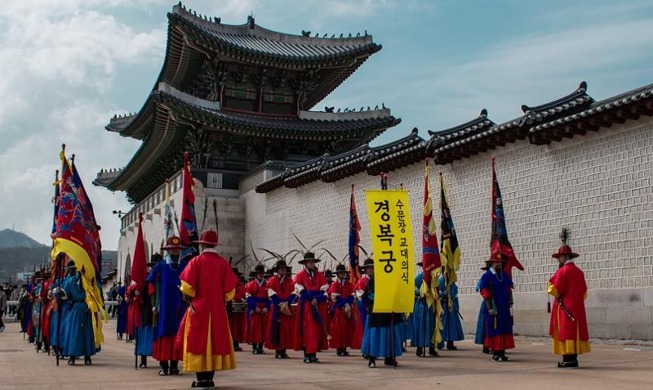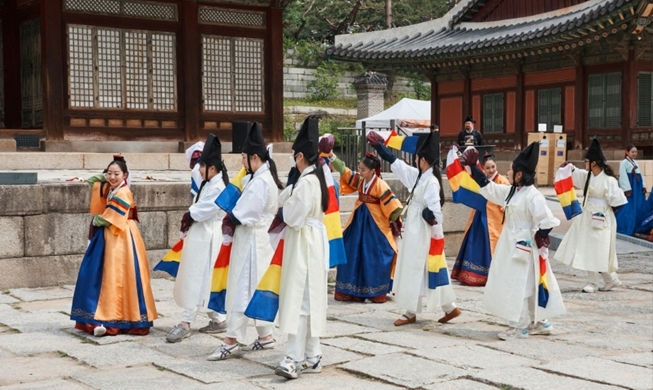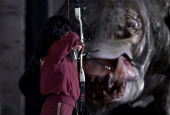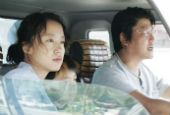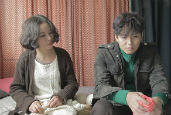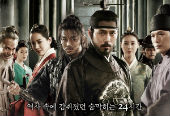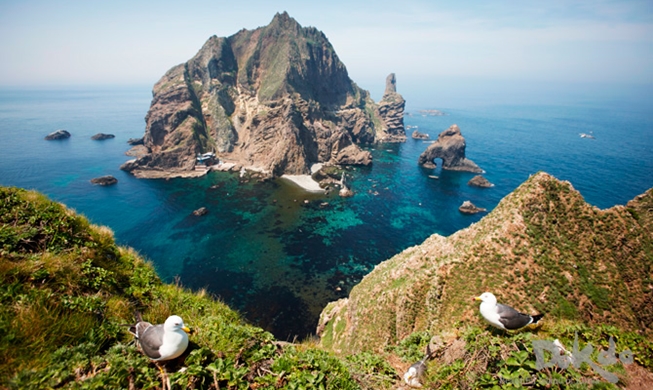-
 Korea.net's 24-hour YouTube channel
Korea.net's 24-hour YouTube channel- NEWS FOCUS
- ABOUT KOREA
- EVENTS
- RESOURCES
- GOVERNMENT
- ABOUT US
The Joseon Dynasty (1392-1910) ruled over Korea for more than 500 years. The lives and times of the 27 monarchs are some of the most widely used material in Korean film. In 2014 alone, a couple of films set with the royal dynasty as background will be released. Earlier this year, theaters saw the release of "The Fatal Encounter," a film which deals with the times of King Jeongjo (r. 1776-1800). Two more films are set to be released later this year. They are "Sado: Memory of Eight Days," which revolves around King Yeongjo (r. 1724-1776), grandfather to Jeongjo, and "Group of Robbers," which focuses on King Cheoljong (r. 1849-1863).
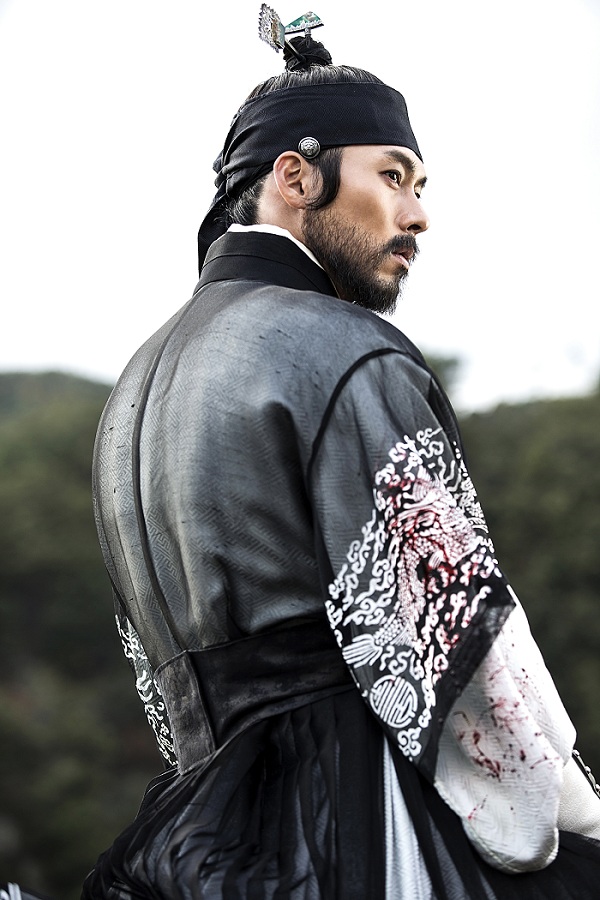
King Jeongjo (1752-1800), the protagonist of "The Fatal Encounter," was a strong monarch. He has often been compared to Louis XIV of France, widely known as "The Sun King." Defining himself as the Man-cheon-myeong-wol-ju-in-ong (萬川明月主人翁), or, “Master of Ten Thousand Rivers and the Moon,” meaning that he can shed light on all creatures, King Jeongjo believed that all were equal under the king. This was reflected in his willingness to communicate and listen. He was always willing to have a conversation with the public.
King Jeonjo made it a lifelong habit to read and publish. Though he passed away before the age of 50, he made many brilliant achievements. One of his achievements was writing the Hongjaejeonseo (弘齋全書), 100 volumes of his daily poetry and prose. Also, the Suwon Hwaseong (水原 華城) fortress, with its mixture of both Asian and European military defensive characteristics, was constructed under his rule. Thanks to its registration on the UNESCO World Heritage list, the castle remains the same as it was 200 years ago. In addition, the publication of the Hwaseong Seongyeok Uigwe (華城城役儀軌), or, "A Completion Report on the Building of the Hwaseong Fortress," was also added to the UNESCO Memory of the World Register. It is the lengthy record of the fortification's construction, from beginning to end, a laborious work that reveals the king's governing philosophy.
Under the reign of King Jeongjo (r. 1776-1800), there was a sharp conflict between the king and his pro-reformers on the one hand and the bureaucrats on the other, who were against reform and wanted to maintain their privileges. The conflict resulted in a number of incidents between the sly old politicians, with their years and years of experience, and the young king, who overcame many hardships and managed to ascend to the throne. The historical records about King Jeongjo are brought to life on movie screens today.
The film "Sado: Memory of Eight Days" sheds some light on Crown Prince Sado (1735-1762), condemned to death by his father King Yeongjo (r. 1724-1776). Known for being clever and nimble ever since his early childhood years, the successor to the throne showed outstanding talent during his time as regent, but ended up being executed as he got involved in a conflict. His tragic life has often been pictured in a variety of genres, including literature, movies and soap operas.
There’s something more from the age of King Cheoljong (r. 1849-1863), which was dominated by the military. It was a time characterized by conflict, as at this time Western countries began knocking on Joseon's door, a conservative nation hoping to remain as the "hermit kingdom." It was also a time during which the nation fell into poverty due to a growing population that was unable to be economically productive. Naturally, the public's resentment of the rich and the government was higher than at any other time in Korean history.
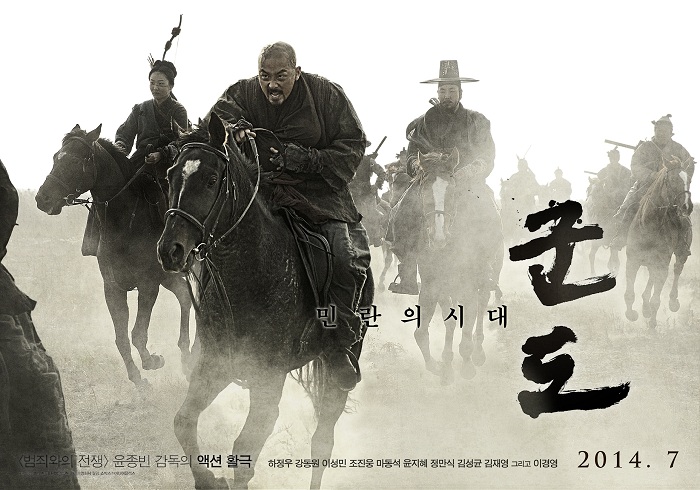
The movie "Group of Robbers" is set in the 13th year of King Cheoljong's reign, 1862, when rampant corruption among the upper classes and government officials reached its peak. The Robin Hood-like story pivots around a group of bandits who lived on the slopes of Jirisan Mountain and who pursued righteousness and justice, fighting for the poor, helpless people.
As seen with the two films above, movies set during the Joseon Dynasty are released again and again. What could be the reason?
First of all, the Joseon Dynasty has 518 years of history and, subsequently, an abundant range of stories related to the period. In particular, the Annals of the Joseon Dynasty, a daily record of national affairs, is the source of many such stories, handed down over the generations. It depicts the daily royal details of more than 500 years of history, including every single movement of the king, trivial incidents that occurred across the country and even natural phenomena. The massive amount of historical records must be attractive source material for a number of directors.
Second, Joseon society was extremely hierarchical. People were classified as either ruling yangban, the aristocrats, as pyeongmin, the middle class, or as nobi, the slaves. There was strict classification, with stringent discrimination between the strata. Conflicts between them were unavoidable. The resistance of the middle classes and slaves against the aristocrats could often be observed. Social movements developed huge power, laying the ground work for the modernization of the nation.
The Joseon Dynasty, existent for half a millennium before the birth of the Republic of Korea, must have been different from the 21st century. However, the problems people had to endure do not show any particularly differences. It was a period of contemplation and deliberation, as the nation sought prosperity, stability and the well-being of the people.
The treasured experiences of previous generations are reenacted and brought life through movies, touching the modern viewer's heart and giving lessons to the people of today.
※ Movies set during the Joseon Dynasty and their related monarch
Face Reader (King Munjong, r. 1450-1452)
King and the Clown (King Yeonsangun, r. 1494-1506)
Jeon Woo Chi: Taoist Wizard (King Jungjong, r. 1506-1544)
Hwangjini (King Jungjong, r. 1506-1544)
Blades of Blood (King Seonjo, r. 1567-1608)
Masquerade (King Gwanghaegun, 1608-1623)
War of the Arrows (King Injo, r. 1623-1649)
The Servant (King Sukjong, r. 1674-1720)
The Accidental Gangster (King Gyeongjong, r. 1720-1724)
Sado: Memory of Eight Days (King Yeongjo, r. 1724-1776)
The Eternal Empire (King Jeongjo, r. 1776-1800)
Untold Scandal (King Jeongjo, r. 1776-1800)
Portrait of a Beauty (King Jeongjo, r. 1776-1800)
The Fatal Encounter (King Jeongjo, r. 1776-1800)
Group of Robbers (King Cheoljong, r. 1849-1863)
The Sword with No Name (King Gojong, 1863-1907)
Gabi (King Gojong, r. 1863-1907)
By Wi Tack-whan, Lee Seung-ah
Korea.net Staff Writers
whan23@korea.kr
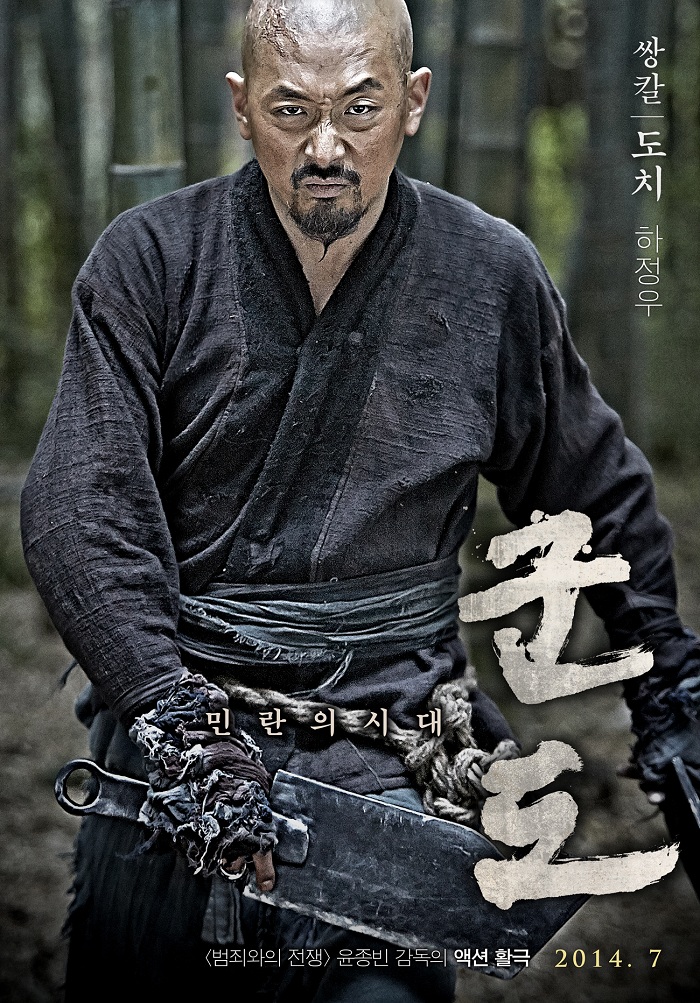
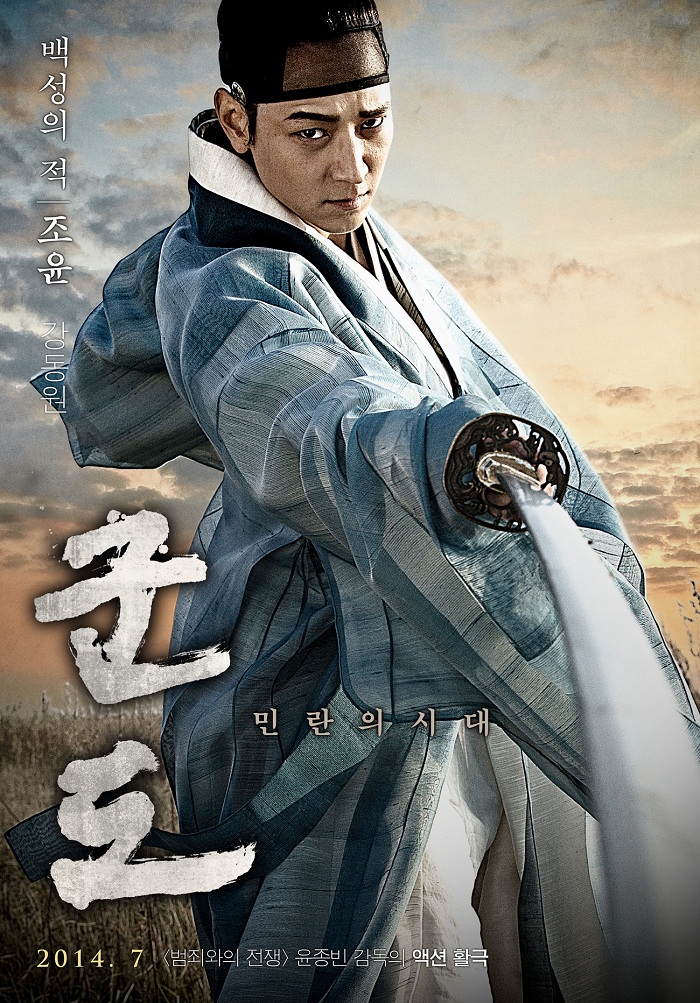

"The Fatal Encounter" pivots around a conspiracy and an attempt at reform in the palace during the reign of King Jeongjo, the 22nd ruler of Joseon. (photo courtesy of All That Cinema)
King Jeongjo (1752-1800), the protagonist of "The Fatal Encounter," was a strong monarch. He has often been compared to Louis XIV of France, widely known as "The Sun King." Defining himself as the Man-cheon-myeong-wol-ju-in-ong (萬川明月主人翁), or, “Master of Ten Thousand Rivers and the Moon,” meaning that he can shed light on all creatures, King Jeongjo believed that all were equal under the king. This was reflected in his willingness to communicate and listen. He was always willing to have a conversation with the public.
King Jeonjo made it a lifelong habit to read and publish. Though he passed away before the age of 50, he made many brilliant achievements. One of his achievements was writing the Hongjaejeonseo (弘齋全書), 100 volumes of his daily poetry and prose. Also, the Suwon Hwaseong (水原 華城) fortress, with its mixture of both Asian and European military defensive characteristics, was constructed under his rule. Thanks to its registration on the UNESCO World Heritage list, the castle remains the same as it was 200 years ago. In addition, the publication of the Hwaseong Seongyeok Uigwe (華城城役儀軌), or, "A Completion Report on the Building of the Hwaseong Fortress," was also added to the UNESCO Memory of the World Register. It is the lengthy record of the fortification's construction, from beginning to end, a laborious work that reveals the king's governing philosophy.
Under the reign of King Jeongjo (r. 1776-1800), there was a sharp conflict between the king and his pro-reformers on the one hand and the bureaucrats on the other, who were against reform and wanted to maintain their privileges. The conflict resulted in a number of incidents between the sly old politicians, with their years and years of experience, and the young king, who overcame many hardships and managed to ascend to the throne. The historical records about King Jeongjo are brought to life on movie screens today.
The film "Sado: Memory of Eight Days" sheds some light on Crown Prince Sado (1735-1762), condemned to death by his father King Yeongjo (r. 1724-1776). Known for being clever and nimble ever since his early childhood years, the successor to the throne showed outstanding talent during his time as regent, but ended up being executed as he got involved in a conflict. His tragic life has often been pictured in a variety of genres, including literature, movies and soap operas.
There’s something more from the age of King Cheoljong (r. 1849-1863), which was dominated by the military. It was a time characterized by conflict, as at this time Western countries began knocking on Joseon's door, a conservative nation hoping to remain as the "hermit kingdom." It was also a time during which the nation fell into poverty due to a growing population that was unable to be economically productive. Naturally, the public's resentment of the rich and the government was higher than at any other time in Korean history.

"Group of Robbers" is set in the middle of 19th-century Joseon. It depicts the lives of the common people as they resist oppressive power and unjust authority. (photo courtesy of Showbox Mediaplex)
The movie "Group of Robbers" is set in the 13th year of King Cheoljong's reign, 1862, when rampant corruption among the upper classes and government officials reached its peak. The Robin Hood-like story pivots around a group of bandits who lived on the slopes of Jirisan Mountain and who pursued righteousness and justice, fighting for the poor, helpless people.
As seen with the two films above, movies set during the Joseon Dynasty are released again and again. What could be the reason?
First of all, the Joseon Dynasty has 518 years of history and, subsequently, an abundant range of stories related to the period. In particular, the Annals of the Joseon Dynasty, a daily record of national affairs, is the source of many such stories, handed down over the generations. It depicts the daily royal details of more than 500 years of history, including every single movement of the king, trivial incidents that occurred across the country and even natural phenomena. The massive amount of historical records must be attractive source material for a number of directors.
Second, Joseon society was extremely hierarchical. People were classified as either ruling yangban, the aristocrats, as pyeongmin, the middle class, or as nobi, the slaves. There was strict classification, with stringent discrimination between the strata. Conflicts between them were unavoidable. The resistance of the middle classes and slaves against the aristocrats could often be observed. Social movements developed huge power, laying the ground work for the modernization of the nation.
The Joseon Dynasty, existent for half a millennium before the birth of the Republic of Korea, must have been different from the 21st century. However, the problems people had to endure do not show any particularly differences. It was a period of contemplation and deliberation, as the nation sought prosperity, stability and the well-being of the people.
The treasured experiences of previous generations are reenacted and brought life through movies, touching the modern viewer's heart and giving lessons to the people of today.
※ Movies set during the Joseon Dynasty and their related monarch
Face Reader (King Munjong, r. 1450-1452)
King and the Clown (King Yeonsangun, r. 1494-1506)
Jeon Woo Chi: Taoist Wizard (King Jungjong, r. 1506-1544)
Hwangjini (King Jungjong, r. 1506-1544)
Blades of Blood (King Seonjo, r. 1567-1608)
Masquerade (King Gwanghaegun, 1608-1623)
War of the Arrows (King Injo, r. 1623-1649)
The Servant (King Sukjong, r. 1674-1720)
The Accidental Gangster (King Gyeongjong, r. 1720-1724)
Sado: Memory of Eight Days (King Yeongjo, r. 1724-1776)
The Eternal Empire (King Jeongjo, r. 1776-1800)
Untold Scandal (King Jeongjo, r. 1776-1800)
Portrait of a Beauty (King Jeongjo, r. 1776-1800)
The Fatal Encounter (King Jeongjo, r. 1776-1800)
Group of Robbers (King Cheoljong, r. 1849-1863)
The Sword with No Name (King Gojong, 1863-1907)
Gabi (King Gojong, r. 1863-1907)
By Wi Tack-whan, Lee Seung-ah
Korea.net Staff Writers
whan23@korea.kr






